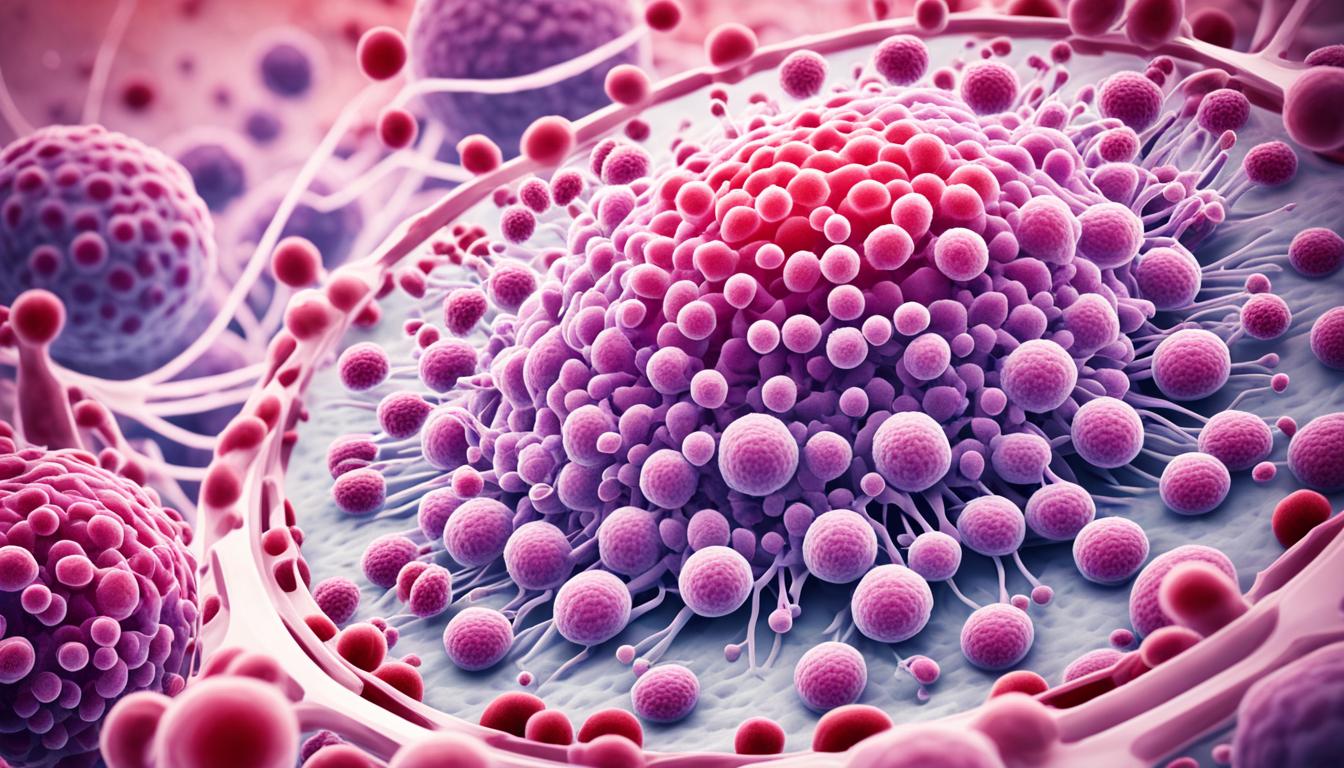German measles, or rubella, is a contagious disease. It’s caused by the rubella virus and known for its symptoms. They include fever, cough, and a red rash. This rash starts on the face and then spreads to the body.
It’s mainly spread through coughing and sneezing. If a pregnant woman gets it, she can pass it to her baby. This can be very dangerous for the unborn child. Getting the MMR vaccine is the best way to prevent rubella. Women who are pregnant should make sure they are immune to protect their baby.
Stem cell therapy is now being looked at as a way to help with rubella complications. It can’t cure rubella yet, but it might help with the problems it can cause. This therapy works by fixing or replacing the cells and tissues that were damaged by the virus.
Key Takeaways:
- German measles, or rubella, is a contagious disease caused by the rubella virus.
- Symptoms include fever, cough, runny nose, inflamed eyes, and a spreading red rash.
- Rubella is transmitted through respiratory droplets and can be passed from mother to fetus during pregnancy.
- The MMR vaccine is the most effective way to prevent rubella.
- Stem cell therapy is being explored as a potential treatment for rubella complications.
Causes and Transmission of Rubella
Rubella, or German measles, comes from the rubella virus in the Togaviridae family. It’s a highly contagious RNA virus. It moves from person to person mainly through the air. When someone with rubella coughs, sneezes, or talks, they release tiny droplets that carry the virus. Breathing in these droplets can infect others nearby.
Infections peak in spring when the virus spreads more. If you touch the mucus or breathe the air of an infected person, you could get rubella too. What’s scary is the virus spreads even before the red rash shows up, making it hard to avoid.
Anyone not immune can catch rubella, especially if they’re not vaccinated. It spreads fast, causing outbreaks in unvaccinated groups. So, it’s really important to get vaccinated against rubella.
Transmission of Rubella:
Rubella can be spread in two main ways:
- Touching an infected person’s mucus or breathing their droplets.
- Breathing in the infected droplets.
Once someone breathes in the rubella virus, it starts to multiply in their body. It infects their respiratory tract, lymph nodes, and more. This leads to common rubella signs like fever and a red rash.
Preventing rubella’s spread is crucial, especially to protect pregnant women. The best way is getting the MMR vaccine. This vaccine guards against not only rubella but also measles and mumps.
Symptoms and Complications of Rubella
Understanding rubella symptoms is key for spotting it early. These signs often show up 16 to 18 days after contact. They mimic flu symptoms such as fever. Some might even confuse it for the flu. Symptoms include:
- Fever: A sign of rubella is a mild fever, ranging from 100 to 102 degrees Fahrenheit.
- Rash: A red rash starts on the face and slowly moves across the whole body. This lasts for about 2 to 3 days. It’s not itchy but might cause itching around the nose and eyes.
- Swollen Lymph Nodes: Rubella can make lymph nodes in your neck and behind your ears swell and hurt.
- Other Symptoms: Flu-like signs such as headache, fatigue, sore throat, and a runny nose may also show up.
Sometimes, rubella symptoms may not be usual, making diagnosis hard. This is especially true for pregnant women. Rubella can cause serious problems in the first three months of pregnancy, such as miscarriage or birth defects. This is called congenital rubella syndrome and can cause the following issues:
- Small Children: Kids born with CRS might be much smaller than usual, affecting their growth.
- Psychomotor Retardation: CRS can lead to slow development, affecting both movement and learning.
- Deafness and Blindness: CRS can cause hearing and vision problems. This might lead to full or partial deafness and blindness.
- Heart Disease: Babies with CRS might have heart problems right from birth.
Preventing Rubella Complications
Prevention is key because rubella can be dangerous, especially for pregnant women. The best way to prevent it is by getting the MMR vaccine. This vaccine protects against rubella, measles, and mumps. Two doses are usually given in childhood. Pregnant women should check if they are immune to rubella to protect their baby.
| Rubella Complication | Prevention |
|---|---|
| Miscarriage and Stillbirth | Ensuring rubella immunity before pregnancy. |
| Congenital Rubella Syndrome | Get vaccinated before getting pregnant and have prenatal checks. |
| Birth Defects | Ensure you’re immune with vaccines and get early pregnancy care. |
By learning about rubella symptoms and ways to prevent it, we can avoid its risks. Early spotting, getting vaccinated, and prenatal care help a lot. They reduce how much rubella affects both kids and grown-ups.
Advances in Stem Cell Therapy for Rubella
Stem cell therapy is looking into treating rubella issues, especially those that harm the fetus. Although there is no direct rubella treatment yet, this therapy is showing that it might help with the impacts of the syndrome. It uses stem cells to repair or even replace the cells that are hurt, giving people new hope.
Scientists are working hard to see if stem cell therapy is truly effective and safe for rubella. Early studies are promising. They show that stem cells can turn into different types of cells. This helps in fixing tissues. The hope is to ease the problems rubella causes, making life better for the patients and reducing any future bad effects.
Even though using stem cells for rubella is new, progress has been made. There is hope for those hit by this infection. Scientists and doctors are aiming to create treatments that target rubella problems, especially for affected fetuses. Achievements in stem cell therapy mark a big move toward beating rubella and the harm it causes.

